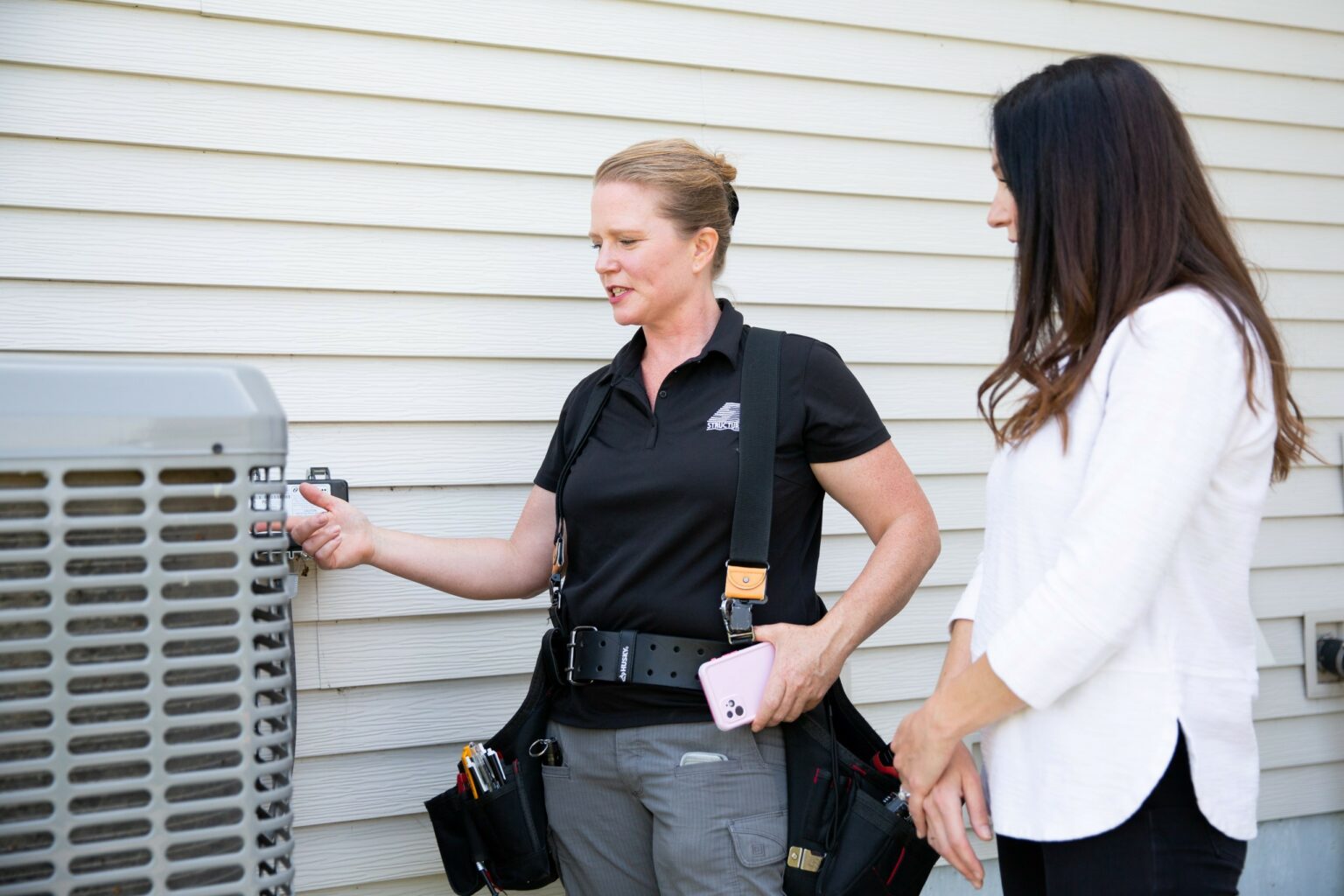Are home inspectors in demand?
Last Updated February 15, 2024


Home inspector Matthew Steger of WIN Home Inspection Elizabethtown in Pennsylvania remembers when he bought his first house in 1998. The interest rate was seven percent–same as when we wrote this article. But the property? The value has more than doubled.
While many homeowners jump for joy when their properties appreciate, Steger is less enthusiastic. With climbing sticker prices, he’s seeing less real estate transactions, which means less home inspections for his business. In fact, the number of inspections Steger’s performing has dropped 60 percent since 2019.
“Sellers don’t want to sell and then be a buyer and go from a three percent [interest rate] to a seven or eight percent [interest rate],” he said. “The price of the house is expensive, but [so is] everything else attached to that: different fees, what you’re going to pay to furnish the house, and all that stuff. Everything is just expensive now.”
Steger isn’t alone. Across the nation, thousands of home inspectors are experiencing a change in demand, and it’s affecting people’s livelihoods. It raises questions throughout the industry:
What’s the average demand for home inspectors in the United States? What contributes to the demand? What is the future of the home inspection industry? Are home inspectors in high demand anywhere? And what can you do to help boost home inspector demand where you live?
In this article, we answer these questions with the help of seven active inspectors.
What’s the demand for home inspectors?
If you Google “how many home inspectors in the US,” you’ll find results estimating 40,000. But in 2024, that may be optimistic.
According to our interviews and housing indicators, the average home inspector is performing 20 to 60 percent less inspections since 2020. Due to the decline in the demand for home inspectors, some inspectors are selling their sole proprietorships to work for multi-inspector firms and get rid of overhead costs. Many inspectors retired early or found jobs in other professions.
“Every year, I’ve climbed in the number of inspections. But since last August, I’m probably down,” said Tracy Andrews of HomeTeam of Scottsdale in Arizona.
For Michael Parkes of RECON Property Inspections in California, the slowdown has been particularly difficult. Parkes’ top priority is his children. So, he puts marketing in the backseat and relies on referrals so he can focus on family. But, he said most of his referrals have dried up.
“For me personally, it’s definitely a lot slower,” Parkes said. “I used to have more regular work, and right now it’s intermittent.”
In Missouri, 2024 ASHI President Mark Goodman of BPG Inspections is also seeing a dip in agent referrals and subsequent inspections. Three years ago, Goodman and his teams were doing about 50 inspections a year for their top four real estate agents. Now, they’re lucky to see those agents 12 times a year.
As a 71-year-old Army veteran, Wind Walker of Walker’s Home & Commercial Inspections in California doesn’t need to work. But if he does continue to inspect, the demand for home inspectors will have to pick up.
“It’d be nice to pass this off to somebody, but if it’s this slow this time next year, I’ll stop my business. I’ll shut it down,” Walker said.
What contributes to the demand for home inspectors?
In January 2023, the National Association of Realtors (NAR) reported a record low housing supply of 1.6 months. To put that in perspective, experts suggest a balanced real estate market has six months of housing supply. NAR’s Housing Shortage Tracker estimates which areas of the United States have insufficient inventory based on how many new permits have been issued to build..
As the NAR continues to monitor the shortage, they’ve found the biggest contributing factors include:
- Higher interest rates
- Higher mortgage rates and home prices
- Rising material costs and supply chain issues after the Covid pandemic
- Labor shortages
- Increasing population due to births and longer lifespans
- More institutional investors
- Decline in new home construction after the Great Recession
In Phoenix, home prices have quadrupled in the last 14 years with the biggest hikes occurring in the summer of 2022, said Andrews. As potential homebuyers get priced out of properties and as interest rates climb, Andrews is seeing less sales and, subsequently, less demand for home inspectors.
“I’m talking to all my REALTORS® who have used me forever, and they’re just like, ‘No, I just don’t have buyers,’” Andrews said. “[Potential clients are] saying they’re going to hold onto their money and ride this roller coaster and see if rates come down enough or prices come down.”
But for our inspectors on the ground, the real estate slowdown isn’t the only reason for declining demand for home inspectors. Even the people actively buying homes are less interested in inspections.
Why are consumers not getting home inspections?
While many are avoiding the housing market due to the high interest rates and low inventory, others are still buying and selling. Those that do face stiff competition.
“A shortage of inventory leads to bidding war conditions. And the bidding war conditions have led to a lot of people foregoing home inspections,” Goodman said.
To fight for the limited available housing, homebuyers are routinely offering much more than the asking price–in cash, if they can. To sweeten the deal, many are also waiving contingencies, which allow them to back out of the purchase with their earnest money deposit intact. By waiving contingencies, including their right to a home inspection, buyers hope to look favorable to sellers. The increasing number of homebuyers forfeiting contingencies has contributed to the decreased demand for home inspectors.
These kinds of “feeding frenzies” aren’t good for buyers, said 2023 ASHI President Lisa Alajajian Giroux of HomeQuest Consultants, Inc. in Massachusetts. In an attempt to secure housing, buyers with insufficient knowledge about a home’s components and defects are abandoning their rights to learn.When they discover defects later, which they often do, they’re left holding the bag.
“I had one job where [the buyer] didn’t even know 60 percent of his house was under a crawlspace. His kids were getting sick, and I found the crawlspace. It was full of dead rats, raccoons, and feces, and mold. It cost him about $95,000 to remediate that crawlspace,” she said.
Pressure for Clean Offers

Some home inspectors argue it isn’t the buyers’ fault for waiving their inspections. They argue real estate agents and sellers discourage inspections–not for the buyers’ benefit, but for their own. Skipping the inspection and lowering the demand for home inspectors makes it easier to close the deal and get their commission, argue some inspectors.
“When I question an agent, they’ll say, ‘Oh, it’s not me. I would never tell my client to waive an inspection,’” Alajajian Giroux said. “But the buyer will tell me, ‘Yeah, I was advised that we probably won’t get an offer accepted if we have the inspection contingency, so we should waive it.”
Goodman has witnessed a similar phenomenon with builders. He said some are putting unrealistic standards in place to increase the barrier to entry for inspectors because, if inspectors find defects on the property, it costs them precious time, money, and resources.
“Bigger builders are doing everything they can to make it harder for a home inspector to even walk on the property and do an inspection,” Goodman said.
Parkes said builders only allow inspectors who look out for the builders’ interests. For example, some in his area make inspectors sign waivers saying the inspector will protect them, the builder, from potential litigation.
While there’s certainly anecdotal evidence of bad apples, it’s important to note that plenty of agents and builders look out for their clients and encourage inspections. And the more inspectors can educate agents and builders on the importance of inspecting, the more those parties can encourage clients to get inspections, too.
A Search for the Middle Ground
As they waive inspection contingencies to write more competitive offers, some homebuyers search for alternatives to pre-sale inspections. One increasingly popular substitute is preliminary buyer walkthroughs–also known as consultation inspections, buyer consultations, and walk-and-talk inspections. These 30-minute meetings in which inspectors name potential defects they can spot with a quick scan of the property give clients a taste of what might be lurking within the walls of their homes but they fail to tell the full story.
“In Massachusetts, what’s hurting us is there’s a lot of inspectors doing walk-and-talks,” Alajajian Giroux said. “The agents are thinking that this is a new way of doing business, and it’s not. This does not substitute a home inspection. There’s so much that is being missed with these walk-and-talks.”
As some homebuyers opt for these shortcut consultations, others wait until after they move in to discover potential defects. Five to 10 percent of the inspections Goodman performs are post-close. And about half the time, Goodman finds something significant that the buyer could have used to negotiate $10,000 or more to repair.
For Steger, about 40 percent of his current business is post-close inspections.
“Obviously it’s good for them to know what they bought, but it’s kind of late for them to do anything with that info other than do the repairs themselves. Obviously, they can’t negotiate anything at that point because they own the home. But there are people who are at least still interested to find out what they bought,” Steger said.
Are home inspectors in high demand anywhere?
Of the seven inspectors we spoke with, only one had seen an increase in the demand for home inspections. That was Todd Gourley of Reveal360 Inspection Services, LLC in Colorado. Gourley attributes his healthy home inspector demand to his location and his marketing.
“Northern Colorado is so popular. There is such a need for housing, and the local cities and towns are building so much new construction,” he said. “I see a continued increase for me in the future, and it’s not all new construction. It’s just the location.”
While buyers’ home inspections still make up 75 percent of his business, Gourley diversifies with ancillary services, new construction inspections, and pre-warranty expiration inspections. He also has strong working relationships with a high-volume house flipper, a nearby university, and real estate agents. Those relationships, in addition to his heavy investments in marketing, have helped Gourley maintain home inspection demand.
“If I was just relying on a buyer’s inspection, then I would be having trouble, as well,” Gourley said.
What is the future of the home inspection industry?
Between August and September 2023, NAR reported that pending home sales rose 1.1 percent. While September 2023’s pending sales rate was still 11 percent lower September 2022, inspectors are hopeful.
“My house doubled in the last eight years in price. I don’t see [home prices] coming back to where they were,” Andrews said. “I think interest rates will maybe get to five [percent], and I think that’s enough to bring all the buyers out.”
In Massachusetts, home inspectors in the ASHI New England chapter have drafted a bill to make who waives inspection contingencies anonymous so it’s no longer advantageous to do so. Inspectors hope this will protect consumers’ rights to inspections and reinvigorate the industry.
“Everyone’s watching that bill. If it gets passed, they think you’re going to see a wave across the country: groups of home inspectors and chapters pushing for the same type of bill in their states,” Goodman said.
You can learn more about the bill here.
How can I manage risk during uncertainty and fluctuating demand for home inspectors?
While we have high hopes for the future of the home inspection industry, we don’t have a crystal ball. So what can we recommend during these uncertain times? Here are four ways to manage your risk.
1. Don’t cut corners.
With so few inspections available, it may be tempting to cut your inspections short. You may think you’ll attract more clients with the promise of a quick inspection. Or you may be eager to run home to attract more customers with your social media marketing.
No matter what’s pressuring you, remember to take your time and perform a thorough inspection–complete with a pre-inspection agreement signed before you start. After all, nothing brings referrals like a job well-done.
2. Consider joining a multi-inspector firm.

If you can’t consistently book enough inspections to make a living, consider joining an established multi-inspector firm. While they won’t do all the work for you, most multi-inspector firms have marketing budgets and staff fostering relationships and generating awareness. If you’re newer to the business, joining a larger inspection company can give you valuable experience before you branch out on your own.
“Go be an inspector and see if you even want to do this for the rest of your life,” Andrews said. “Work for another team, a big company first, and see if you like it. See if you want to do it, see if you’re going to be good at it.”
If you do opt to join a multi-inspector firm, be sure they cover their employees with errors and omissions (E&O) and general liability (GL) insurance. Learn more about the two insurance types here.
3. Provide ancillary services.
Remember our outlier, Todd Gourley? In addition to living in a growing area, Gourley’s continued to grow his inspection business by performing ancillary services. Ancillary services are add-on or stand-alone examinations outside the scope of a standard home inspection. By offering more services, you can make more money, diversify your business, and differentiate yourself.
Gourley also encourages people to shadow professionals in residential construction, like HVAC technicians and electricians, to learn systems and components better than your peers.
While Walker’s calls for standard home inspections have slowed, his bookings for mold inspections have kept him busy.
“We’re having hotter summers and wetter winters, so the mold…is [in] higher [demand]. Plus, people are getting sick and they’re finding out that it’s actually dangerous to breathe the spores. So they’re becoming more educated,” Walker said. “I’m not rocking and rolling, but my mold inspections pay the bills.”
Before you offer ancillary services, endorse your insurance policy for protection against specialty inspection-related claims. Learn more about endorsements here.
4. Take advantage of discounts.
As an ASHI member, you gain access to many programs that can save you money.
“Take advantage of all the discount programs that ASHI or other organizations can provide. That does help,” Goodman said. “If you take advantage of programs like ASHI’s new health care program, it pays for your ASHI dues 10 times over.”
And it isn’t just health care discounts available to you as an ASHI member. With InspectorPro with the ASHI Advantage, you can receive discounts on the following aspects of your E&O and general liability policy:
- Annual premium
- Equipment coverage
- Retirement or “tail” coverage
- Deductibles for model inspection agreement, years without claims, and early reporting
With the ASHI Advantage, you also qualify for free:
Apply for InspectorPro with the ASHI Advantage here.
Hope for New Inspectors
In this difficult market, many are cautioning prospective inspectors from joining the industry. But there’s a light at the end of the tunnel. There is still a need for home inspectors, and that need may be increasing soon.
“We’re going to have a very large demand for home inspectors in the future, in the next three to five years when this settles, because [other home inspectors] have left,” Alajajian Giroux said.
As interest rates lower and inventory increases, as clean offers become outdated and walk-and-talks lose appeal, homebuyers will need home inspectors like you. So, if you’ve been asking, “Should I become a home inspector?” the answer might be a resounding “yes!” very soon. You may be able to respond to the shortage of home inspectors industry leaders see on the horizon.
This year, in Managing Risk, we’re writing for the underdogs, the prospective and new home inspectors entering the industry at this strange and unprecedented time. We’ll cover topics like the pros and cons of the profession and building trust. We’ll talk about ways to engage the community and opportunities for mentorship. And, as your risk management gurus, we’ll let you know how to manage your risk against claims every step of the way. Stay tuned.





